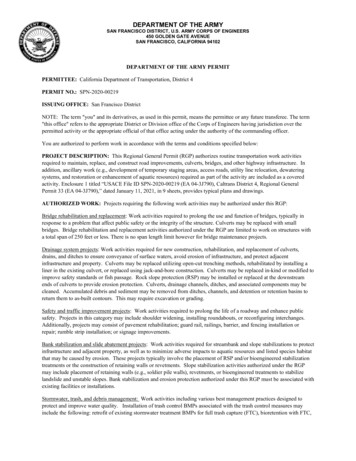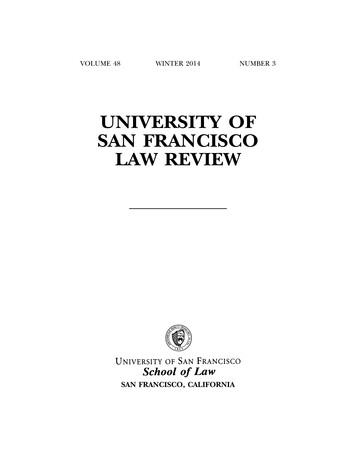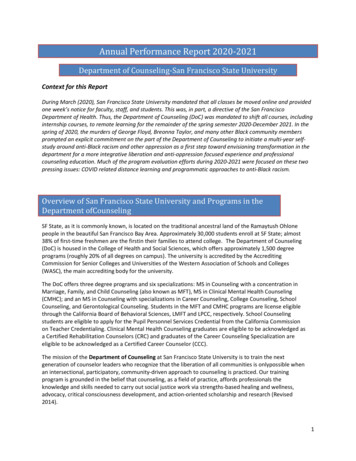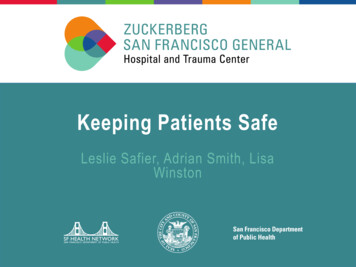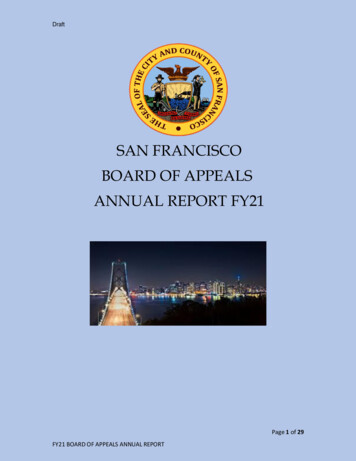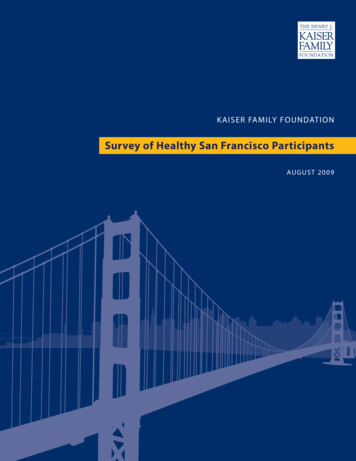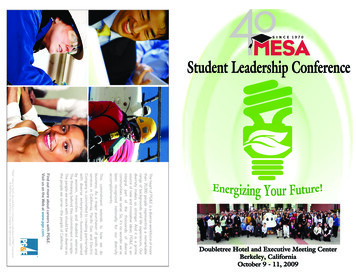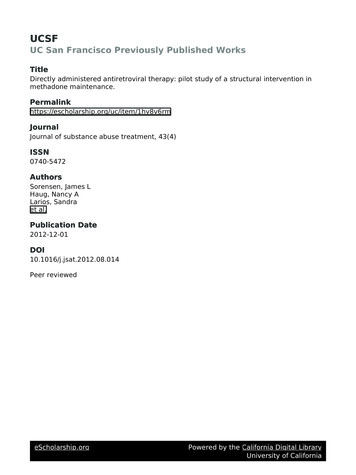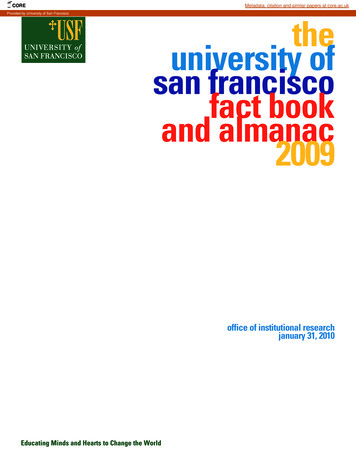
Transcription
COREProvided by University of San FranciscoMetadata, citation and similar papers at core.ac.uktheuniversity ofsan franciscofact bookand almanac2009office of institutional researchjanuary 31, 2010Educating Minds and Hearts to Change the World
table of contentsbrief history.1basic facts.3select honors and achievements in 2009. 4student profile.5faculty profile.8staff profile.9alumni profile.10academic programs by school/college.11library holdings.14financial resources.14athletics.15key events during 2009.16faculty/staff publications and awards in 2009.18sources.21
a briefhistoryOn October 15, 1855, the school opened itsdoors to its first class. Three students showedup, a number that gradually grew to 65 by 1858.In 1859, Anthony Maraschi, S.J., the foundingpresident of Saint Ignatius Academy, incorporated the institution under California state law,obtained a charter to issue college degrees,formed a board of trustees, and renamed theinstitution Saint Ignatius College. Studentenrollment, composed largely of first- andsecond-generation Irish and Italian immigrants,increased to 457 by 1862.The University of San Francisco began in 1855as a one-room schoolhouse named SaintIgnatius Academy. Its founding is interwovenwith the establishment of the Jesuit Order inCalifornia, European immigration to the westernUnited States, and the population growth ofCalifornia and San Francisco as a result of theCalifornia Gold Rush.Further growth in the number of students and rising property taxes prompted Saint Ignatius Church and College to movein 1880 to the corner of Hayes Street and Van Ness Avenue,the current site of the Louise M. Davies Symphony Hall. Thecollege opened its doors to 650 students and rave reviews inthe local press. The institution occupied a full city blockand was described as having “scientific laboratories anddepartments” as “thoroughly equipped as money can makethem” and a library that contained “the cream of knowledgeon all necessary subjects.” The attached church was describedas “magnificent” and could hold up to 4,000 people. In 1903,the college added a “splendid new gymnasium,” described asthe best in the city.The history of St. Ignatius Church and College at this locationcame to an abrupt end on April 18, 1906. On the morning ofthat day, an earthquake, followed by several days of fire,brought the church and college, and most of San Francisco, toalmost complete ruin. The city and the institution, however,quickly rebuilt from the devastation. In September 1906, SaintIgnatius Church and School reopened in temporary quarters, known as the “shirt factory,” on the southwest corner ofHayes and Shrader streets, currently the site of one of thebuildings of St Mary’s Medical Center. In 1927, St. Ignatius1
College moved into its new Liberal Arts Building, the present Kalmanovitz Hall, near the corner of Fulton and ParkerStreets. In 1930, at the request of several alumni groups,Saint Ignatius College changed its name to the University ofSan Francisco.For 154 years, the University of San Francisco has servedthe citizens of San Francisco and enriched the lives of thousandsof people. The institution has graduated students who went on tobecome leaders in government, education, business, journalism,sports, and the legal and medical professions. Among itsalumni, the university counts three San Francisco mayors, aUnited States Senator, four California Supreme Court Justices,a California Lieutenant Governor, two Pulitzer Prize winners,three Olympic medalists, several professional athletes, andthe former president of Peru.Today the University of San Francisco enrolls morethan 9,000 students in its five schools and colleges: TheSchool of Law, founded in 1912; the College of Arts andSciences, organized in 1925; the School of Business andProfessional Studies, which began in 1925 as the College ofCommerce and Finance and was merged with the College ofProfessional Studies in 2009; the School of Education, whichstarted as the Department of Education in 1947 and wasupgraded to a school in 1972; and the School of Nursing,which began as the Department of Nursing in 1948 andbecame a school in 1954. USF is one of the most ethnicallydiverse universities in the nation. Among the entire fall 2009student population, more than 36 percent are Asian, AfricanAmerican, Latino, or Native Hawaiian/Pacific Islander, andnearly 10 percent are international.Central to the mission of the University of San Franciscois the preparation of men and women to shape a multiculturalworld with generosity, compassion, and justice. The institution’s most recent Vision, Mission, and Values Statement,approved by the Board of Trustees on September 11, 2001, aftera year of formulation and campus-wide participation, capturesthe essence of this commitment in its opening paragraph:“The University of San Francisco will be internationally recognized as a premier Jesuit Catholic, urban University with aglobal perspective that educates leaders who will fashion amore humane and just world.” This mission permeates allaspects of the institution, including student learning andfaculty development, curriculum design, program and degreeofferings, alumni relations, publications, and a host of otherinstitutional features.In 2005, the University of San Francisco celebrated the 150thanniversary of its founding. The main USF campus currentlyoccupies 55 acres near Golden Gate Park in San Francisco. Inaddition, the university offers classes at four Northern Californiaregional campuses and at a Southern California regional campus.The schools and colleges comprising the institution also offerstudents a multitude of international experiences and studyabroad programs that enrich the learning community and fulfillthe university’s mission. The institution has grown dramatically since its modest beginning. It continues, however, to fulfilla mission that stretches back in time to the founding of theSociety of Jesus in 1540 by St. Ignatius of Loyola, that took rootin San Francisco in 1855, and that flourishes today in a premier Jesuit Catholic University.2
usf basicinformationFULL NAME OF INSTITUTION:University of San FranciscoADDRESS:2130 Fulton Street, San Francisco, CA 94117-1080WEB SITE ADDRESS:www.usfca.eduGENERAL INFORMATION PHONE NUMBER:415 422-5555PRESIDENT:Stephen A. Privett, S.J.PROVOST:James L. WiserSPONSORSHIP AND CONTROL:USF is an independent, private, non-profit institution of higher educationgoverned by a 43-member Board of Trustees. It is one of the 28 Jesuit Catholiccolleges and universities in the United States.FOUNDING AND CHARTER:USF was founded in 1855 and was granted a charter by the State of Californiato issue college degrees in 1859.ACCREDITATIONThe University of San Francisco is accredited by the Western Association ofSchools and Colleges (WASC), an accreditation first granted in 1950 by theWestern College Association (WCA), the antecedent of WASC. Periodically,USF’s accreditation is reaffirmed by WASC.USF is also accredited by several professional accrediting bodies, including,but not limited to, the American Bar Association (ABA), the CaliforniaCommission on Teacher Credentialing, AACSB International–The Associationto Advance Collegiate Schools of Business, and the Commission on CollegiateNursing Education (CCNE).CLASSIFICATION BY THE CARNEGIE FOUNDATION FORTHE ADVANCEMENT OF TEACHING:USF is classified as a Doctoral/Research and Community Engaged University.Under the new Carnegie Foundation classification system, USF is characterized as balancing arts, sciences, and the professions at the undergraduatelevel; as doctoral/professional dominant at the graduate level; with themajority of its students being undergraduates; as selective, with a highlevel of transfer-in students; and as a medium-sized, four-year, and primarilyresidential institution. In 2006, USF received the community engagementclassification in both possible categories, curriculum engagement and outreach and partnership.3
selectfirsts,honors,andachievementsin 2009USF was listed as a Tier One National University in the 2010 U.S. News& World Report, and was rated 30th in the magazine’s separate ranking ofnational universities regarding undergraduate student ethnic diversity.nUSF tied for 10th place in The Chronicle of Higher Education’s ranking oftop producers of Fulbright scholars among faculty members at research institutions in 2009 10, and was one of only 22 research institutions to be listed.nFor the third year in a row, the Corporation for National and CommunityService selected USF for the President’s Higher Education CommunityService Honor Roll with Distinction, one of only 19 schools nationwide toreceive this honor in three successive years. Reasons for selection includedthe large number of students engaged in service-learning and communityservice in a single year, the total number of hours USF students were soengaged, the exemplary nature of USF’s community service projects, andthe quality of projects that addressed the year’s special focus on service toimprove high school graduation and college readiness for youth from disadvantaged circumstances.nUSF was ranked among the top 100 universities in the nation for civicengagement, according to a 2009 published study, which surveyed morethan 3,000 institutions. The study, titled “Saviors of Our Cities: Survey ofBest College and University Civic Partnerships,” was conducted by EvanDobelle, president of Westfield State College in Massachusetts.nThe USF School of Law was listed as one of the top 100 law schools inthe 2010 U.S. News & World Report rankings, and it was 14th in the magazine’s separate diversity rankings. In addition, USF’s part-time JD programranked 28th out of 86 schools in the magazine’s first listing of part-timeprograms. USF students’ average LSAT scores ranked 13th among studentsin all part-time programs.nA 2009 report by the National Science Foundation noted that among bachelor of science graduates from the natural sciences in USF’s College of Artsand Sciences, 8.5 percent went on to earn doctorates from 2000 to 2008,more than twice the national average among comparable institutions.nThe USF Chapter of Beta Alpha Psi, an honorary organization of financialinformation students and professionals, achieved superior chapter statusin 2009, the highest recognition from that national organization. The USFstudents, in the School of Business and Professional Studies, logged in1,122 professional development hours and 821 hours of community service.nIn 2009, nursing school graduate and professional funk style streetdancer Marina Stankov-Hodge received a Fulbright arts grant to teachdance choreography, potentially in conjunction with reproductive healtheducation in Brazil. Marina is currently conducting research for a master’sthesis on health policy at the Geneva School of Diplomacy and InternationalRelations in Geneva, Switzerland. She is the third recent USF student towin a Fulbright, following Kelko Petrosky in 2004-05. and Su-Lin Throndsonin 2000-01.nIn 2009, the USF School of Education became the first school in the nationto offer an emphasis in human rights for masters and doctoral educationstudents. Seventeen international and multicultural education studentsenrolled in the emphasis in the Spring 2009 semester.n4
usf studentprofileStudent EnrollmentSTUDENT ENROLLMENT BY COLLEGE, AS OF CENSUS DATE:As of September 11, 2009 (Census Date), theUniversity of San Francisco enrolled 9,036students, including 5,432 undergraduatestudents, 2,708 graduate students, 727 lawstudents, and 169 special/non-degree students.COLLEGE OF ARTS AND SCIENCES:3742(3056 undergraduate students, 686 graduate students)SCHOOL OF BUSINESS ANDPROFESSIONAL STUDIES:2619(1751 undergraduate students, 868 graduate students)SCHOOL OF NURSING:895(625 undergraduate students, 270 graduate students)SCHOOL OF EDUCATION:USF’s coed student body (38.3 percent male and61.7 percent female) represents diverse ethnic,religious, social, and economic backgrounds,75 foreign countries, and 47 states.884(all graduate students)SCHOOL OF LAW:727SPECIAL STUDENTS:169(111 undergraduate students, 58 graduate students)Annual Student Costs (2009-2010)TRADITIONAL UNDERGRADUATETuition and fees:Room and Board (average): 34,770/year 11,540/yearPROFESSIONAL STUDIESUndergraduate tuition, per unit:Graduate tuition, per unit: 790 885GRADUATEArts and Sciences, per unit:Business (MBA), per unit:Education, on-campus masters, per unit:Education, doctoral, per unit:Nursing, on-campus masters per unit:Nursing, on-campus doctoral per unit: 1075 1160 975 1085 995 995SCHOOL OF LAWFull-Time Tuition:Part-Time (evening) Tuition:5 37,230/year 1,330/unit
Financial AidStudent Ethnicity andReligious AffiliationsDuring the 2008-2009 academic year, 56.4 percent of USF’s undergraduatesapplied for financial aid and were determined to have need. Of those students,98 percent were awarded financial aid: 54.0 percent received institutionalgrants, 23.4 percent received federal Pell Grant support, and 18.0 percentreceived federal Perkins loans.USF is rated 30th in the ethnic diversity of its students among 262national universities in the 2010 U.S. News & World Report and 18thamong 366 institutions of higher education in the 2008 Princeton Review.IN FALL 2009, THE TOTAL STUDENT POPULATION,BY ETHNICITY WAS:Freshman FactsAsian:African American:Latino:Native American:Native Hawai’ian/Pacific Islander:International:Unspecified:White:Total:The University of San Francisco enrolled 1073 first-time freshmenin the fall semester of 2009. Salient facts about the freshman classinclude:The class entered with an average GPA of 3.5.The class had an average combined SAT score of 1119.1505 (16.7%)472 (5.2%)1099 (12.2%)80 (0.9%)118 (1.3%)878 (9.7%)1395 (15.4%)3489 (38.6%)9,036The first-time freshman class had 743 females (69.2%) and 330 males(30.8%)IN FALL 2009, THE TRADITIONAL UNDERGRADUATE STUDENTPOPULATION, BY ETHNICITY WAS:Among the class members, 23.7% were from Catholic high schools, 2.7%from Jesuit Catholic high Schools, 51.1% from public high schools, 13.1%were from private high schools, and 3.7% were from non-Catholic religioushigh schools.Asian:African American:Latino:Native American:Native Hawai’ian/Pacific Islander:International:Unspecified:White:Total:IN THE FALL OF 2009, THE FIRST-TIME FRESHMAN STUDENTPOPULATION, BY ETHNICITY WAS:White:Asian:Latino:Unidentified:African American:International:Multi-ethnic:Other/Preffer not to Disclose:Native American:Native Hawai’ian/Pacific Islander:Total:375 (34.9%)206 (19.2%)200 (18.6%)2 (0.2%)53 (4.9%)87 (8.1%)0 (0%)114 (10.6%)19 (1.8%)17 (1.6%)1,073996 (20.0%)203 (4.1%)711 (14.3 %)47 (0.9%)78 (1.6%)476 (9.5%)685 (13.7%)1791 (35.9%)4987IN THE FALL OF 2009, AMONG TRADITIONAL UNDERGRADUATESTUDENTS, THE RELIGIOUS AFFILIATIONS WERE:Buddhist:Catholic:Hindu:Jewish:Muslim:No religion:Other:Protestant:Unspecified:Community Service andService LearningFor the academic year ending in May 2009, 2,155 undergraduatestudents participated in service learning courses, representing 39.7% of theundergraduate Retention Rates and Graduation DataFor the freshman class beginning in the fall of 2008, the freshman-to-sophomoreretention rate was 82.4%USF has more than 50 student organizations, and six living-learning communities dedicated to community service.The six-year graduation rate for full-time first-time freshmen entering in fall2002 was 66.6%During the 2008-09 academic year, USF students engaged in nearly166,000 hours of community service work.6
Degrees AwardedDURING 2008–2009, USF AWARDED2,586 DEGREES, INCLUDING:bachelor’s degreesmaster’s degreesdoctoral degreeslaw degrees1,2991,03061196Student EvaluationsON THE MAY 2009 USF GRADUATING STUDENT SURVEY,96.3% of the students reported that “my instructors took an active interestin my learning.”95.5% of the students reported that “my instructors were reasonablyaccessible outside of class.”93.3% of the students reported that “overall, I was satisfied with my USFeducation.”ON THE SPRING 2008 NATIONAL SURVEY OFSTUDENT ENGAGEMENT,87% of the seniors reported that their experience at USF contributed “quite abit” or “very much” to “thinking critically and analytically.”78% of the seniors reported that their experience at USF contributed “quite abit” or “very much” to “working effectively with others.”86% of the seniors evaluated their “entire educational experience” at USFas “good” or “excellent.”Career and Educational PlansIn 2009, 29.3% of USF’s graduating seniors reported that they planned toattend graduate school after graduation.In 2009, 22.4% of USF’s graduating seniors reported that they planned tostart a new job or continue a current job.From 2000 to 2009, 67.1 percent of USF students who went through the USFPre-Professional Health Committee were successful in gaining admittanceto medical school, whereas nationally the acceptance rate during this periodwas 45.0 percent.7
usf facultyprofileBy rank, full-time faculty included:Full ProfessorsAssociate ProfessorsAssistant ProfessorsInstructorsAt the beginning of the 2009–2010 academicyear, USF employed 386 full-time faculty members.129 (33.4%)125 (32.4%)116 (30.1%)16 (4.1%)By gender, full-time faculty included:In the fall of 2009, the ratio of full-time equivalentstudents to full-time equivalent faculty was 15:1.MenWomen205 (53.1%)181 (46.9%)By ethnicity, full-time faculty included:Among USF’s full-time faculty, 92 percent holdthe highest or terminal degree in their academicdiscipline (e.g., Ph.D., Ed.D, J.D., M.F.A.).African AmericanAsian/Pacific IslanderLatino/aNative AmericanInternationalWhiteUSF was among the top 10 research universitiesin the nation in the number of Fulbright scholarsin produced in 2009–10, with four USF facultymembers receiving that prestigious award.21 (5.4%)36 (9.3%)25 (6.6%)3 (0.7%)14 (3.6%)287 (74.4%)A 2004–2005 SURVEY BY THE HIGHER EDUCATION RESEARCHINSTITUTE AT UCLA, FOUND THAT AMONG USF FULL-TIMEFACULTY MEMBERS:70.3 percent had engaged in public service/professional consulting withoutpay over the past two years (among faculty in all private four-year schools,the corresponding percentage was 52.5 percent of the faculty).83.0 percent agreed that their values were congruent with the dominantinstitutional values (among faculty in all private four-year schools, thecorresponding percentage was 76.8 percent).As of December 2008, current USF facultymembers (including administrators with facultyappointments) had published 6,107 booksand scholarly articles, and were cited in48,653 additional publications.USF employed 553 part-time faculty membersduring the fall of 2009.USF has 14 endowed faculty chairs.8
usf staffprofileAmong full-time employees,the positions l personnelNon-faculty ProfessionalsTechnical/paraprofessionalsClerical and secretarial personnelSkilled crafts personnelService/maintenance personnelAs of November 1, 2009, USF had 1,158 full-timeand 721 part-time employees, for a total of 1,879faculty and staff. USF is the twentieth largestemployer in the city and county of San Francisco.Among part-time employees,the positions lSkilled craftsNon-faculty professionalsTechnical/paraprofessionalsClerical and 3128882841Merit Award Winners for 2009FR. WILLIAM J. DUNNE AWARDJulie Reed, Office of Service Learning and Community Action, Leo T.McCarthy Center for Public Service and the Common GoodMERIT AWARDSTonya Miller, Student Academic Services, College of Arts and SciencesWay Leon, Information Technology ServicesLisa Kosiewicz, International Student and Scholar Services, University LifeDiane Marbello, University AdvancementIGNATIAN FACULTY SERVICE AWARDRonald Sundstrom, Philosophy, College of Arts and SciencesFACULTY-SERVICE LEARNING AWARDSeth Wachtel, Art Architecture, College of Arts and SciencesSARLO PRIZESteven Shatz, School of LawCIT AWARDS FOR USE OF TECHNOLOGYCarina Ljungwald, Politics, College of Arts and SciencesMouwafac Sidaoui, School of Business and Professional StudiesDISTINGUISHED TEACHING AWARD FROM THE USFFACULTY ASSOCIATION AND USF FOR 2008–2009Joaquin Gonzales III, Politics and Philippine Studies, College of Arts and SciencesDISTINGUISHED RESEARCH AWARD FROM THE USFFACULTY ASSOCIATION AND USF FOR 2008–2009Benjamin Wells, Mathematics and Computer Science, College of Artsand Sciences9
usf alumniprofileNotable USF alumni include:A current California Supreme Court Justice (MING CHIN),and three former California Supreme Court Justices (MATTHEWSULLIVAN, JEREMIAH SULLIVAN, and RAYMOND SULLIVAN)A former California Lieutenant Governor (LEO T. MCCARTHY)USF has 88,416 alumni living in all 50 states,6 United States territories, and 111 countries.A former United States Senator (JAMES PHELAN)A current member of the United States House of Representatives(LYNN WOOLSEY), and two former members (JOHN BURTON andJOHN SHELLEY)Among USF’s living alumni, there are more than4,000 teachers, 1,450 educational administrators,580 engineers, 2,800 attorneys, 360 college professors,470 elected and non-elected government officials, 630 accountants, 1,100 health care providers, 1,870 nurses, 380 physicians, 160 dentists,and 270 social workers.Three former San Francisco Mayors (JAMES PHELAN, JOHN SHELLEY,and FRANK JORDAN)Two Pulitzer Prize winners (JOSEPH ROSENTHAL, FOSTER CHURCH)The former Undersecretary for the Smithsonian Institute (SHEILA BURKE)The current Undersecretary of the Department of Education (MARTHAKANTER)The former President of Peru (ALEJANDRO TOLEDO)The former San Francisco Police Chief (HEATHER FONG), the first womanand first Asian to hold that positionThe first Asian admitted to the practice of law in California history(CHAN CHUNG WING)303 USF alumni have joined the Peace Corpssince that agency was established in 1961,placing USF in the top twenty five amonginstitutions of comparable size regarding theaverage annual placement numberof Peace Corps volunteers.The former Press Secretary for President John F. Kennedy(PIERRE SALINGER)The former chairman of Price Waterhouse World Firm (DOMINIC TARANTINO)The prominent historian and former California State Librarian (KEVIN STARR)The former Commissioner of the National Football League (PETE ROZELLE)Three Olympic Medal winners (OLLIE MATSON, BILL RUSSELL, andK.C. JONES)The head coach for an Olympic Gold Medal team (JIMMY NEEDLES)Three members of the Pro Football Hall of Fame (OLLIE MATSON,From 1912 (the year the USF School of Lawwas founded) to 2008, 266 law schoolalumni became judges.GINO MARCHETTI, BOB ST. CLAIR)Numerous star players in the National Basketball Association(BILL RUSSELL, K.C. JONES, MIKE FARMER, BILL CARTWRIGHT,PHIL SMITH)The current president of Thai Frozen Food Products(THIRAPHONG CHANSIRI)Among USF’s alumni, 51 percent live in theBay Area, 24 percent live in California outsidethe Bay Area, 20 percent live in the United Statesoutside of California, and 4 percent live outsidethe United StatesThe current president and CEO of Intel Corporation (PAUL OTELLINI)Two recipients of MacArthur Fellowship “Genius” Grants: The NationalForensics Coach of the Year (TOMMIE LINDSEY), The Founder of theStreet Soldiers National Consortium (JOSEPH MARSHALL, JR.)Philanthropist, composer, civic leader (GORDON GETTY)Auxiliary Bishop of the Archdiocese of San Francisco (FR. WILLIAM JUSTICE)10
academicprogramsby schoolor collegeCOLLEGE OF ARTS AND SCIENCESDEAN: JENNIFER TURPINDEPARTMENTS, PROGRAMS, CENTERS & INSTITUTES4/3 Law ProgramAdvertisingAfrican-American StudiesAfrican StudiesArt and ArchitectureArchitecture and Community DesignArt History/Art ManagementFine ArtsDesignAsian StudiesMinorUndergraduateAsian StudiesB.A./B.S.-MAPSAsian-American StudiesAsia Pacific StudiesBiologyUndergraduateGraduateCatholic StudiesCenter for Latino Studies in the Americas (CELASA)Center for the Pacific RimChemistryUndergraduateGraduateChild and Youth StudiesClassical StudiesCommunication StudiesComparative Literature and CultureComputer ScienceUndergraduateGraduateComputer ScienceEmphasis in EntrepreneurshipWeb ScienceDavies ForumDual Degree Program in Teacher Financial AnalysisInternational Development EconomicsRisk ManagementInvestor RelationsEnglishEnglish as a Second LanguageEnvironmental ManagementEnvironmental ScienceEnvironmental StudiesErasmus Program (Living Learning Community)Esther Madriz Multicultural Scholars (Living Learning Community)Ethnic StudiesEuropean StudiesExercise and Sport ScienceForeign Language Writing CenterFreshman Seminars11
COLLEGE OF ARTS AND SCIENCESSCHOOL OF BUSINESSAND PROFESSIONAL STUDIESCONTINUEDDEAN: MIKE DUFFYGarden Project (Living Learning Community)Gender and Sexualities StudiesHealth StudiesHistoryHonors Program in the HumanitiesInternational StudiesUndergraduateGraduateJapan Policy Research InstituteJapanese StudiesJudaic Studies (Swig Program in Jewish Studies and Social Justice)KUSF Radio 90.3 FMLane Center for Catholic Studies and Social ThoughtLatin American StudiesLatino Chicano StudiesLegal StudiesLeo T. McCarthy Center for Public Service and Common GoodMartín Baró Scholars Program (Living Learning Community)MathematicsMedia StudiesMilitary ScienceModern and Classical LanguagesLanguage CenterForeign Language CenterNautilus InstituteNatural ScienceNerosciencePeace and Justice StudiesPeace and Justice Studies AssociationPerforming ArtsPhilippines StudiesPhilosophyPhysics and AstronomyPoliticsPre-Professional Health ProgramPsychologyPublic ServiceRhetoric and CompositionRicci Institute for Chinese Western Cultural HistorySociologySport ManagementSt. Ignatius InstituteThacher GalleryTheology and Religious StudiesUndergraduateGraduateWriting Program, MFABusiness Administration, B.S/B.A. Majors: Accounting, Business Administration, Entrepreneurship andInnovation, Finance, Hospitality Industry Management, InternationalBusiness, Management, MarketingBusiness Administration, M.B.A.Areas: Entrepreneurship, Finance, International Business, Management,Marketing, Telecommunications Management and Policy,Global Entrepreneurship and ManagementSpecialized ProgramsMBA for ExecutivesLaw and business combination (J.D./M.B.A.) programMasters in Asia Pacific Studies and Business (M.A.P.S./M.B.A.) programMasters in Environmental Science and M.B.A. (M.S.E.M./M.B.A.) programMasters of S cience in Financial Analysis and MBA Program (MSFA/MBA)PROFESSIONAL STUDIESUndergraduate Degree Programs:Applied Economics, B.S.Health Services, B.S.Information Systems, B.S.Organizational Behavior and Leadership, B.S.Public Administration, B.P.A.Public Administration(with emphasis in Law Enforcement Leadership), B.P.A.Public Administration(with emphasis in Nonprofit Administration), B.P.A.Graduate Degree ProgramsOrganization Development, M.S.Information Systems, M.S., M.S.N./M.S.I.S.Nonprofit Administration, M.N.A.Project Management, M.S.P.M.G.TPublic Administration, M.P.A.Public Administration(with emphasis in Health Services Administration), M.P.A.,M.S.N./M.P.A.SCHOOL OF LAWDEAN: JEFFREY BRANDJuris Doctor, J.D., J.D./M.B.A.Master of Laws in International Transactionsand Comparative Law, LL.M.Master of Laws in Intellectual Property and Technology Law, LL.M.12
SCHOOL OF EDUCATIONSCHOOL OF NURSINGCredentials ProgramsMaster of Arts in Counseling Psychology with an Emphasis inEducational Counseling and a Pupil Personnel Services CredentialMaster of Arts in Learning and Instruction witha Mild/Moderate Education Specialist CredentialMaster of Arts in Organization and Leadership with a PreliminaryAdministrative Services CredentialPreliminary Administrative Services CredentialClear Administrative Services CredentialPreliminary Single Subject Teaching CredentialPreliminary Single Subject Teaching Credential - BCLAD EmphasisPreliminary Multiple Subject Teaching CredentialPreliminary Multiple Subject Teaching Credential - BCLAD EmphasisSchool Counseling Pupil Personnel Services CredentialSpecialist Education Mild/Moderate Education Specialist CredentialMaster of Arts in Teaching with a Preliminary Singleor Multiple Subject Teaching CredentialMaster of Arts in Teaching Reading with a Preliminary Singleor Multiple Subject Teaching CredentialBachelor of Science in Nursing (BSN)Graduate ProgramsMSN Program for the Non-Nurse:MSN Clinical Nurse Leader (CNL)MSN P
USF was founded in 1855 and was granted a charter by the State of California to issue college degrees in 1859. ACCREDITATION The University of San Francisco is accredited by the Western Association of Schools and Colleges (WASC), an accreditation first granted in 1950 by the Western College Association (WCA), the antecedent of WASC. Periodically,



